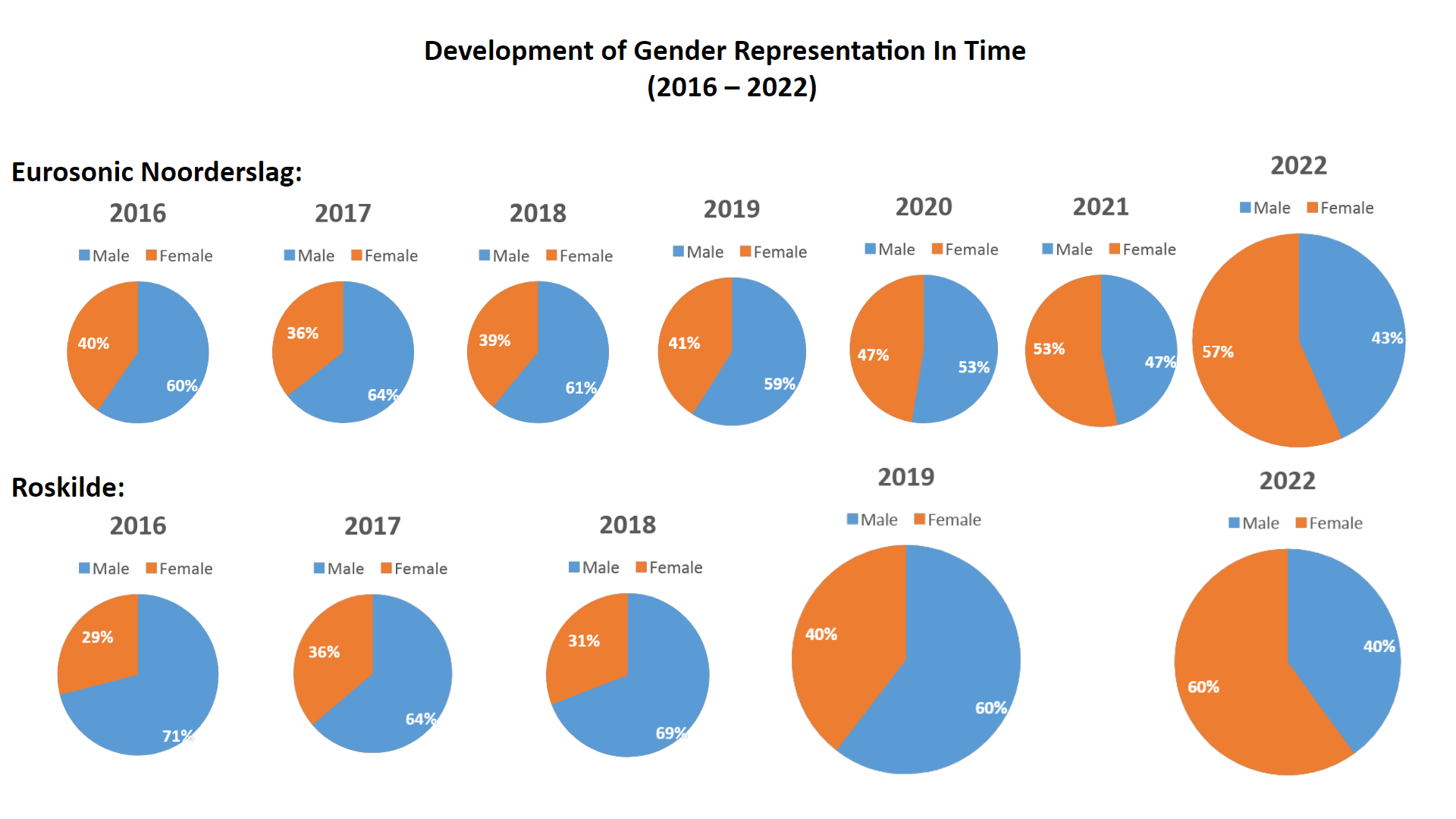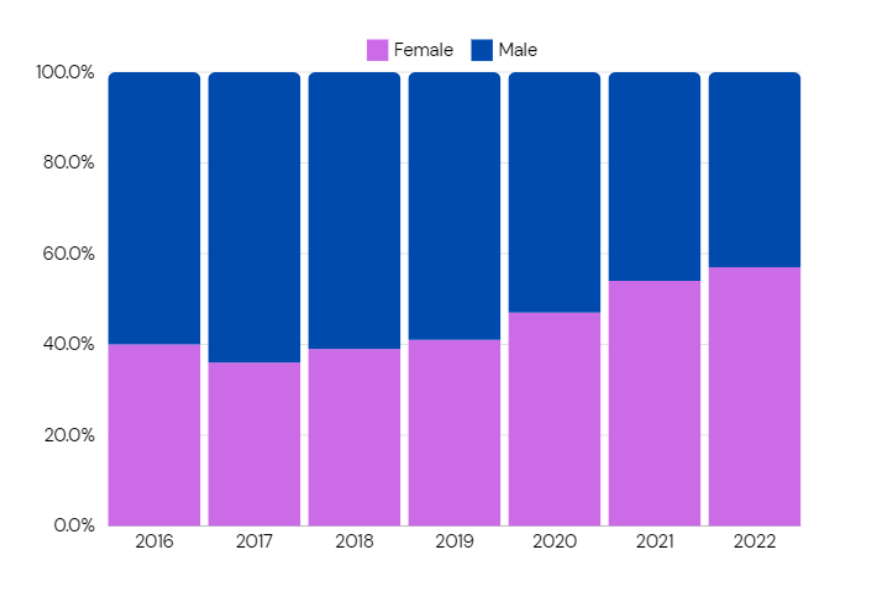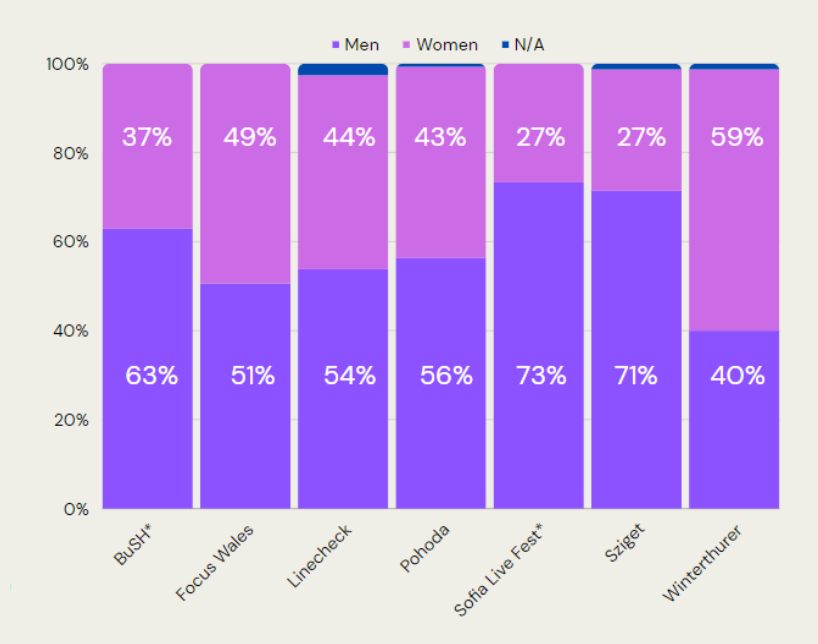Voorlopige resultaten
Momenteel hebben zeven masterstudenten hun onderzoek binnen dit project afgerond. Lees hier de uitgebreide publiekssamenvatting, waarin meer wordt uitgewijd over de onderzoeksmethodiek en theorie.
Diversiteit op Roskilde en ESNS
Student Cultural Leadership Dan Padure deed onderzoek naar de man-vrouwverdeling bij showcasefestivals Eurosonic Noorderslag (Nederland) en Roskilde (Denemarken) over de periode 2016-2022. Ook keek hij naar de representatie van mensen van kleur op deze festivals.
Opvallend aan het onderzoek van Dan is dat het diversiteitsbeleid van beide festivals hun vruchten afwerpt. In 2016 bestond het merendeel van de acts op de line-up uitsluitend uit mannelijke leden (71% bij Roskilde en 60% bij ESNS), maar sinds 2019 zien we een verschuiving naar een meer 50/50 verdeling. Er was zelfs een meerderheid van de acts met een gemengde of volledig vrouwelijke artiesten: 60% op Roskilde en 57% op ESNS. Een belangrijke nuance is dat het totale aantal mannelijke artiesten op dit moment in beide gevallen nog steeds aanzienlijk hoger is. We zien echter een sterke daling in het aantal volledig mannelijke acts, ten gunste van meer diverse acts.

Volgens Dan groeit sinds 2016 ook de aandacht voor de representatie van niet-witte artiesten op festivals, met Roskilde als duidelijke voorloper, hoewel het moeilijk is om harde conclusies aan de cijfers te verbinden. Dit komt omdat de focusgebieden en boekingsprocessen van beide festivals erg verschillen. Uit het onderzoek van Dan komt wel naar voren dat er sinds 2020 meer aandacht komt voor diversiteit op het podium. De discussies rondom onderwerpen als geestelijke gezondheid en sociale bewegingen zoals ‘Black Lives Matter’ hebben misschien een rol gespeeld achter de versnelling van een meer representatief line-up beleid.
Vrouwen zwaar ondergerepresenteerd bij ESNS Exchange-programma
Gaststudent Juan Carlos Mendez Alvarez (Universiteit Utrecht) focuste zich in zijn onderzoek op hoe de genderbalans van line-ups op ESNS verschilde met de acts die via het uitwisselingsprogramma ESNS Exchange werden geboekt. Juan Carlos keek in zijn onderzoek naar de artiesten die tussen 2016 en 2019 twee maal of meer door het ESNS Exchange-programma zijn geboekt.
Uit de onderzoeksgegevens van Juan Carlos blijkt dat, zelfs bij een 50/50-beleid vanuit ESNS, gemiddeld ongeveer 80% van de geboekte acts door het ESNS Exchange programma mannelijk is, tegenover 20% vrouw. In 2019 was bijvoorbeeld 40% van de ESNS-acts vrouw, maar dit zie je niet terug in de geboekte acts via het ESNS Exchange-programma - 83% van de geboekte acts is man.

Groot verschil showcasefestivals en commerciële festivals
Vervolgens keken studenten Ricardo Robers, Eryn Kelly, Terezie Kvetonova, Aina Forteza Gomez en Lea Gohdes naar de diversiteit van Europese partners van Eurosonic, zoals Linecheck (Italië), Focus (Wales) en Sofia Live Fest (Bulgarije). Wat blijkt: showcasefestivals hebben een meer evenwichtiger line-up dan commerciële festivals, zoals Sziget (71% man). Ook merkten de studenten een groot verschil tussen festivals uit West-Europa en de voormalige Oostbloklanden.

Festivalprogrammeurs: Mannelijke bands leveren meer op?!
Deze discrepantie in representativiteit roept natuurlijk vragen op. Hoe kan er zo’n groot verschil zijn? Speelt de demografie van boekingskantoren een rol in welke acts worden geboekt en welke niet? Welke besluitvorming gaat daaraan vooraf? Welke morele en commerciële overwegingen worden er gemaakt? Daarvoor spraken de studenten met vier (mannelijke!) festivalprogrammeurs over kansengelijkheid in de boekingsindustrie en de achterliggende motivatie van programmeurs. Uit de openhartige gesprekken kwam naar voren dat programmeurs primair kijken naar de professionaliteit en kwaliteit van de act, hoe populair de act is (bijvoorbeeld op social media) en of de act bij een festival past. Tegelijkertijd zijn er ook formele en informele netwerken die het boekingsproces beïnvloeden. Dat gaat over vriendschappen en relaties tussen programmeurs en artiesten of hun managers.
Hoewel iedere geïnterviewde aangaf een vrouwelijke boeker in zijn team te hebben, was er geen enkele organisatie met een vrouw in een beslissende functie. Er was maar één festival dat een diversiteitsmedewerker in dienst had. Wel gaven alle programmeurs aan het gesprek over diversiteit op de werkvloer erg belangrijk te vinden. Wanneer er echter financiële prikkels in het spel zijn, kiezen programmeurs toch vaak voor de veilige optie: een grote, vaak mannelijke act.
De studenten presenteerden de resultaten van hun onderzoek op de ESNS conferentie in januari 2023 en januari 2024 en tijdens het Music Mattersevent in maart 2023.
Vervolgonderzoek
Vanuit ESNS liggen er nog veel vragen op de kast. Geïnteresseerd in een vervolgonderzoek? Mail dan met tawi rug.nl.
-
Hoe is de genderverdeling bij boekingskantoren? Zijn daar scheve verhoudingen en kan dat het verschil van het onderzoek van Juan Carlos verklaren? Wat zijn de beweegredenen van boekers bij het boeken via het ESNS Exchange-programma van ESNS? Welke keuzes maken zij?
-
Hoe divers zijn andere festivals in Europa, zoals Glastonbury, Reading festival, Leeds festival en Rock am Ring? Zien we daar dezelfde patronen terug?
-
Zijn er metingsmethodieken op basis van diversiteit die ESNS kan gebruiken? Kunnen we komen tot een standaard waarin je events met elkaar kunt vergelijken?
-
In hoeverre speelt dit thema in niet-westerse Europese landen? Welke thema’s vinden oost-Europese landen belangrijk?
-
Hoe communiceren festivals over hun diversiteitsbeleid? Hoe zie je dat terug in hun social media en website?
-
Living lab: hoe divers is het publiek dat ESNS bezoekt? Zijn deze bezoekers representatief voor de Europese/Nederlandse demografische kenmerken?
-
Hoe divers zijn de Live Europe Music Venues (clubs waar ESNS mee gepartnerd is)? En hoe verhoudt zich dat tot de programmering op ESNS?
